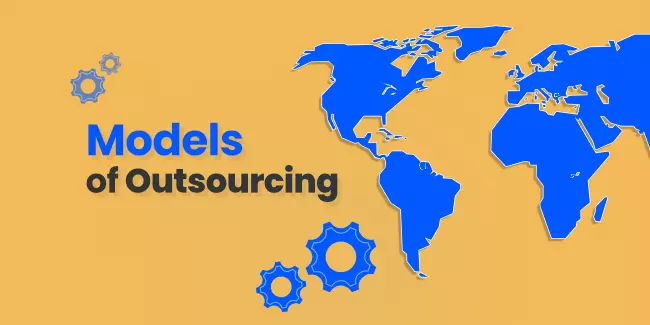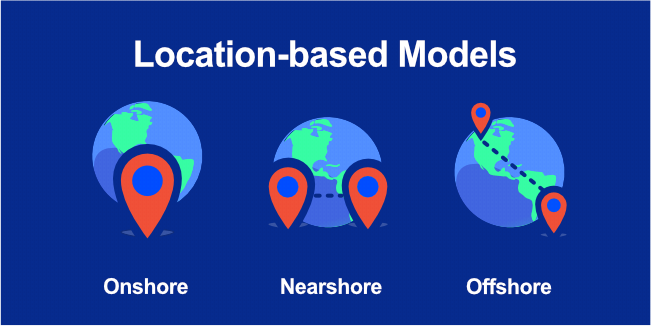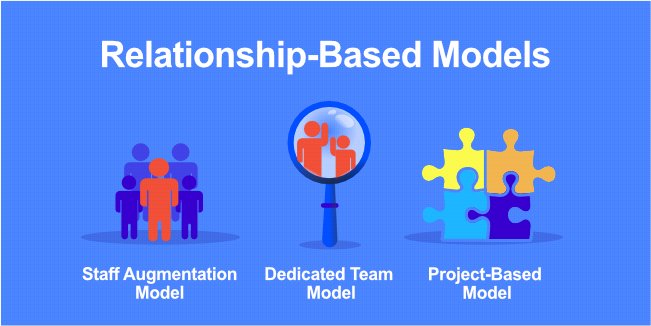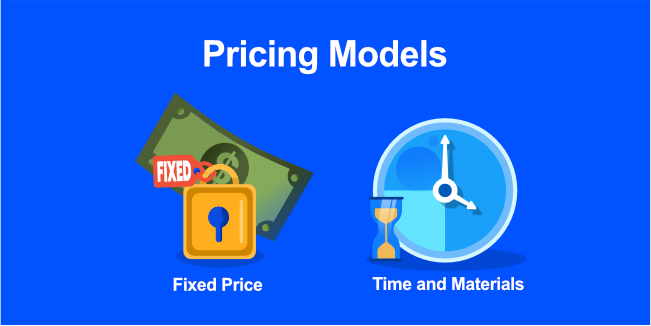Models of Outsourcing

IT outsourcing has been very common for several years, and there is no indication that this trend will change. Many companies outsource various work areas, choosing one of the many outsourcing models.
Whether you want to create a website or a specialized mobile application using artificial intelligence - outsourcing is a solution that will help you gain a market advantage. If you are starting your adventure with outsourcing, you should know this solution's advantages and disadvantages. That's why we created a series of articles about outsourcing because we believe that outsourcing is crucial to success. It is not without reason that both international corporations and startups use it.
In this article, we will introduce the different types of outsourcing models so that you can choose the model that perfectly fits the requirements of your project.
A Few Words about IT Outsourcing
There are several models of IT outsourcing which can be divided into 3 different categories:
- Location-based,
- Relationship-based,
- Pricing models.
To choose the suitable outsourcing model that will meet our requirements, it is necessary to determine what characterizes each model. Thanks to this, you can make a good decision that will positively affect your business.
Location-based Outsourcing Models
In the location-based IT outsourcing model, we distinguish 3 models: Nearshore, Onshore, and Offshore Outsourcing. Each has pros and cons, so it's essential to understand which is right for your business.
Onshore outsourcing means outsourcing the project to an external company in the same country. This solution eliminates the risk associated with the language barrier or time zones. Still, it is usually much more expensive than outsourcing to other countries. Gaining a competitive advantage and the need to offer consumers attractive prices mean that many choose this outsourcing model only for small, short-term projects.
Nearshore outsourcing means outsourcing a project (e.g., software development) to an outsourcing partner based in a neighboring country. This model of outsourcing has many advantages. You can access a larger talent pool, and costs are generally lower than in your home country. The time zone difference is minimal (usually a maximum of 1 hour), so it does not cause discomfort, and the nearshore team is relatively close. This model offers the right balance between profitability and the physical proximity of an outsourced team. Consider this outsourcing model if direct contact with an outsourcing company is crucial.
Offshoring means your service provider is located abroad, usually on another continent. This outsourcing model is the most popular. It is used mainly concerning software development outsourcing, as it is associated with the most favorable prices. However, you must know possible difficulties from different time zones and language restrictions. However, an experienced project manager will be able to manage the development process in such a way as to eliminate any difficulties and establish clear rules of cooperation immediately.
In our article "Offshoring your project - why is it worth it?" you can learn more about this outsourcing model.

When choosing a location-based outsourcing model, you need to consider cost issues, which vary significantly in different locations. For example, software development in the USA is several times more expensive than in Central Europe. In addition, you must decide whether geographical proximity is essential to you. The Covid-19 epidemic has taught everyone to work remotely, but some people do not feel comfortable working this way. However, in the case of offshoring, you have access to an unlimited pool of talent, which is very important for projects that require creativity and high technical knowledge.
Therefore, before deciding on any of the above models, consider your needs and expectations carefully.
Relationship-based Outsourcing Models
There are three different relationship-based outsourcing models. These are Staff Augmentation, Dedicated Team Model, and Project-Based Model. Find their characteristics to choose the model best suited to your needs.
The Staff Augmentation Model consists in joining an existing in-house team of experienced specialists. It can be one person, but it can also be several developers who specialize in an area not developed in your team. Thanks to this model, you save time because you do not have to deal with recruitment, which is usually a long-term process. It is an ideal solution when you lack a specific specialist or suddenly lose an employee for random reasons.
This model works well for short-term projects, but our experience shows that it can also be successfully used for longer cooperation. External specialists temporarily become part of your internal team, and you still have full control over project and process management, expanding only the necessary positions.
In our article "IT Staff Augmentation Services - everything you need to know," we discussed this outsourcing model in detail.
In this IT outsourcing model, an external company will provide you with a dedicated development team that will comprehensively take care of your project. Such a dedicated team will include specialists necessary for a given project. For example, you want to create a mobile application. In that case, the dedicated software development team will consist of developers, business analysts, UX/UI designers, a quality assurance engineer, and a project manager. Of course, the outsourcing company wants the team to include people who work well together and can successfully implement your project. A dedicated team is assigned exclusively to your project but is not part of your company.
This outsourcing model is perfect for complex, long-term projects. Choosing a dedicated team takes work, so we have created an article to make this task easier for you. Please read "How to choose a Dedicated Software Development Team? Everything you should know" and learn about this model.
In this model, you outsource the entire project to an external company. The software outsourcing partner handles the whole development process from start to finish according to the specifications set out at the beginning of the project.
The project-based model is one of the most popular forms of software development outsourcing because all you have to do as a client is provide detailed project requirements. Everything else is up to the outsourcing company. This cooperation model takes you little time, but at the same time, you have the least control over the project because all parts of the development are on the side of the development company. It will only depend on your internal arrangements on how often you will receive a summary of the work progress and to what extent you will be involved in the project if you have such a need.

Before you decide on any of the above outsourcing models, you must carefully analyze your needs and expectations. It is crucial that you also take into account personal preferences regarding the implementation of the project, for example, regarding the level of control. Some people feel comfortable in models with little control over the design, while others have to take care of every.
Outsourcing pricing models
One of the benefits of outsourcing is lower project costs. Outsourcing pricing models have changed over time. Today, the two most popular pricing models are the Fixed Price Model and the Time and Materials Model.
The Fixed Price Model represents the final cost of the project. As a rule, a fixed amount of money is charged every month or after the entire project is handed over. The outsourcing company must know all the requirements and details of the project to estimate the final cost on this basis. This model is more expensive because each external company, as part of the reserve, adds some insurance to the amount that will cover unforeseen costs. This model works well for simple and short-term projects where all requirements are known and are not subject to change during the project. This model is unsuitable for software development projects because they are usually complex projects with many variables that are difficult to estimate.
It is worth remembering that changes to this model are often impossible. But even if they can be implemented, they are expensive and often unprofitable. With subsequent changes in the project, its price may exceed the budget several times.
-
Time and Materials (T&M) Model
The Time and Materials pricing model is a payment for the real amount of work in a given project. The final price consists of the hourly rate of a specific specialist and the actual time he devoted to the project.
Time and Material is a flexible model that allows you to implement changes and improvements on an ongoing basis during the project. Along with the progress of work, the client receives detailed reports and analyzes that verify the progress of work. Starting a project in the Time and Materials model is more straightforward and does not require such precise planning. No need to provide a complete product specification and the initial definition of only the basic functionalities of the project allows for a more efficient start with, for example, a website, and then, along with the subsequent stages of development, specify additional functionalities.
Although it may seem surprising, it often turns out that, in the end, the T&M model is cheaper. In addition, this settlement method translates into a higher quality of service, as both parties can pay more attention to details and adapt the project to new requirements and ideas.

Before choosing a specific pricing model, carefully analyze your situation. If you want to commission a simple project where all the variables are known, you can opt for a model with a fixed price. But if you have a complex project in which you do not have all the functionalities defined, then the Time and Materials Model is the best solution. In our experience, this model is most often used in software development projects.
How To Select Outsourcing Models?
It would be best to analyze several factors to choose an outsourcing model tailored to your needs and requirements. First, you need to evaluate the number of your team's resources in terms of the requirements of a given project.
If you lack 2 or 3 specialists, then the Staff Augmentation model is a good solution. But if you don't have a team that can handle a given project, then it's worth considering a Dedicated Team Model or a Project-Based Model. In addition, you must consider the level of flexibility your project requires and your preferred style of controlling and managing the project. Of course, you always have to consider how much time you have to implement the project and what budget you discount.
In the case of outsourcing, the critical element is an external partner, as a proven supplier will help you smoothly through the entire project development process. In our article "Choosing the right software partner - guide," we discussed this topic in detail because a wise choice will help you maximize the potential of your project and minimize possible risks.
Conclusion
As you can see, there are many different approaches to IT outsourcing. You have many options regarding the location of the third-party partner, how you work together, and how you are billed. Each model has its advantages and disadvantages, which are apparent. However, the selected outsourcing model must fit the requirements and needs of your project.
At mDevelopers, we have been creating successful outsourcing projects for many years, so if you want to talk about it with our specialists, make an appointment for a free consultation at a convenient time.